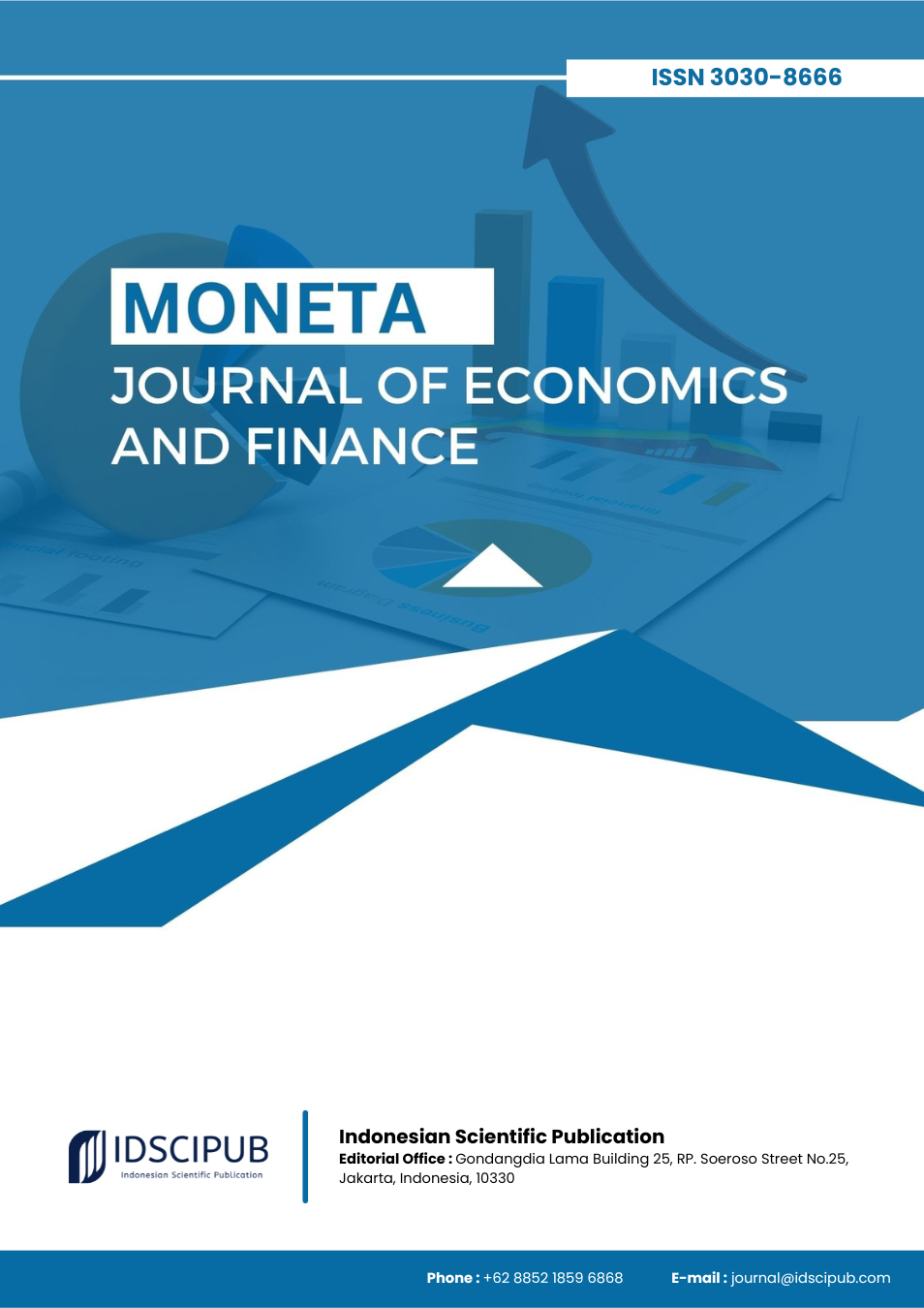Inflation, Monetary Policy, and Systemic Risks: Global Insights from the Post-Crisis Era
DOI:
https://doi.org/10.61978/moneta.v3i4.930Keywords:
Inflation Dynamics, Monetary Policy, Supply Shocks, Fiscal-Monetary Coordination, Global Economic Volatility, Inflation Expectations, Economic RecoveryAbstract
The dynamics of inflation and monetary policy between 2008 and 2025 have been shaped by unprecedented global crises, including the financial crisis, the COVID-19 pandemic, and recurrent energy and commodity shocks. This study aims to synthesize global lessons on how inflation evolves under these conditions and how central banks have responded with both conventional and unconventional policies. The methodology employed a structured narrative review, drawing from Scopus, Google Scholar, Web of Science, JSTOR, and complementary databases. Keywords such as “inflation dynamics,” “monetary policy,” “COVID-19,” “supply shock,” and “economic recovery” guided the search. Inclusion criteria focused on peer-reviewed studies addressing the intersection of inflation and policy during the designated period. The results highlight four key themes. First, external shocks such as energy and food price volatility strongly influence inflation, with greater vulnerability observed in open economies. Second, monetary policy effectiveness varies: advanced economies relied on interest rate adjustments and unconventional tools, while developing economies faced structural limits in transmission. Third, fiscal-monetary coordination enhanced stability, whereas uncoordinated responses fueled uncertainty and inflationary persistence. Finally, public attention and expectations significantly shaped inflation outcomes, limiting the scope of communication strategies. The discussion situates these findings within broader systemic factors including globalization, market structures, and geopolitical risks, underscoring the need for adaptive and credible policy frameworks. This study concludes that future resilience requires strengthening central bank independence, improving coordination, and integrating global risk analysis. Such measures are critical for sustaining price stability in an era of persistent global volatility.
References
Abbas, S. (2024). The new keynesian phillips curve and r* ${r}^{* }$. Australian Economic Review, 57(3), 294-301. https://doi.org/10.1111/1467-8462.12572 DOI: https://doi.org/10.1111/1467-8462.12572
Agnello, L., Castro, V., Jawadi, F., & Sousa, R. (2019). How does monetary policy respond to the dynamics of the shadow banking sector?. International Journal of Finance & Economics, 25(2), 228-247. https://doi.org/10.1002/ijfe.1748 DOI: https://doi.org/10.1002/ijfe.1748
Akram, Q. and Mumtaz, H. (2018). Time‐varying dynamics of the norwegian economy. Scandinavian Journal of Economics, 121(1), 407-434. https://doi.org/10.1111/sjoe.12270 DOI: https://doi.org/10.1111/sjoe.12270
Albahouth, A. (2025). Inflation rate determinants in saudi arabia: a non-linear ardl approach. Sustainability, 17(3), 1036. https://doi.org/10.3390/su17031036 DOI: https://doi.org/10.3390/su17031036
Asadollah, O., Carmy, L., Hoque, M., & Yilmazkuday, H. (2024). Geopolitical risk, supply chains, and global inflation. World Economy, 47(8), 3450-3486. https://doi.org/10.1111/twec.13585 DOI: https://doi.org/10.1111/twec.13585
Ayyoub, M. (2024). International linkages of inflation‐output dynamics: fresh gvar evidence from pakistan and its trading partners. Economic Papers: A Journal of Applied Economics and Policy, 43(3), 236-256. https://doi.org/10.1111/1759-3441.12416 DOI: https://doi.org/10.1111/1759-3441.12416
Bajra, U., Gjeçi, A., & Čadež, S. (2024). At the crossroads of inflation: analyzing central bank responses in noneconomic crises. Studies in Economics and Finance, 42(3), 468-488. https://doi.org/10.1108/sef-04-2024-0246 DOI: https://doi.org/10.1108/SEF-04-2024-0246
Banerjee, S. (2025). Inflation dynamics in india during the twin shocks of covid-19 and ukraine war. South Asian Journal of Macroeconomics and Public Finance. https://doi.org/10.1177/22779787251338902 DOI: https://doi.org/10.1177/22779787251338902
Batool, I., Chandia, K., Sarwar, B., & Iqbal, M. (2022). Fiscal dominance and the inflation dynamics in pakistan: an empirical analysis. Millennial Asia, 15(1), 51-71. https://doi.org/10.1177/09763996221103003 DOI: https://doi.org/10.1177/09763996221103003
Bertella, M., Rego, H., Neris, C., Silva, J., Podobnik, B., & Stanley, H. (2015). Interaction between fiscal and monetary policy in a dynamic nonlinear model. Plos One, 10(3), e0118917. https://doi.org/10.1371/journal.pone.0118917 DOI: https://doi.org/10.1371/journal.pone.0118917
Binner, J., Kelly, L., & Tepper, J. (2025). Professional forecasters vs. shallow neural network ensembles: assessing inflation prediction accuracy. Journal of Risk and Financial Management, 18(4), 173. https://doi.org/10.3390/jrfm18040173 DOI: https://doi.org/10.3390/jrfm18040173
Bora, I., Kırıkkaleli, D., Zoaka, J., Bekun, F., & Ekwueme, D. (2020). Investigating monetary policy dynamics in nigeria: the role of private investment. Management Science Letters, 247-254. https://doi.org/10.5267/j.msl.2019.7.037 DOI: https://doi.org/10.5267/j.msl.2019.7.037
Cabral, I. and Nicolau, J. (2020). Inflation in the g7 and the expected time to reach the reference rate: a nonparametric approach. International Journal of Finance & Economics, 27(2), 1608-1620. https://doi.org/10.1002/ijfe.2233 DOI: https://doi.org/10.1002/ijfe.2233
Candia, B., Coibion, O., & Gorodnichenko, Y. (2024). The inflation expectations of u.s. firms: evidence from a new survey. Journal of Monetary Economics, 145, 103569. https://doi.org/10.1016/j.jmoneco.2024.103569 DOI: https://doi.org/10.1016/j.jmoneco.2024.103569
Cateau, G. (2017). Price‐level versus inflation targeting under model uncertainty. Canadian Journal of Economics/Revue Canadienne D’Économique, 50(2), 522-540. https://doi.org/10.1111/caje.12268 DOI: https://doi.org/10.1111/caje.12268
Chin, K. (2022). Inflation persistence and monetary policy: dsge‐var approach. Manchester School, 90(6), 715-729. https://doi.org/10.1111/manc.12420 DOI: https://doi.org/10.1111/manc.12420
Daway-Ducanes, S. (2017). On decreasing marginal impatience, stability and monetary policy in a sidrauskian economy. Metroeconomica, 69(1), 86-108. https://doi.org/10.1111/meca.12170 DOI: https://doi.org/10.1111/meca.12170
Değirmen, S., Tunç, C., Saltık, Ö., & Rehman, W. (2023). Do oil price shocks differently matter for oil exporter and importer developing countries?. Journal of Economic Studies, 50(8), 1775-1788. https://doi.org/10.1108/jes-10-2022-0543 DOI: https://doi.org/10.1108/JES-10-2022-0543
Domínguez, B. and Gomis‐Porqueras, P. (2019). The effects of secondary markets for government bonds on inflation dynamics. Review of Economic Dynamics, 32, 249-273. https://doi.org/10.1016/j.red.2018.10.004 DOI: https://doi.org/10.1016/j.red.2018.10.004
Finck, D. and Tillmann, P. (2022). The role of global and domestic shocks for inflation dynamics: evidence from asia. Oxford Bulletin of Economics and Statistics, 84(5), 1181-1208. https://doi.org/10.1111/obes.12495 DOI: https://doi.org/10.1111/obes.12495
Freitas, R. (2024). Monetary and fiscal policies in brazil and the behavioral approach. Economia, 26(1), 108-126. https://doi.org/10.1108/econ-12-2023-0206 DOI: https://doi.org/10.1108/ECON-12-2023-0206
Hu, Y. and Zhang, P. (2021). Performance of china’s core inflation measures for monetary policy. The Singapore Economic Review, 69(07), 2207-2234. https://doi.org/10.1142/s0217590821500168 DOI: https://doi.org/10.1142/S0217590821500168
Jordá, Ó. and Nechio, F. (2023). Inflation and wage growth since the pandemic. European Economic Review, 156, 104474. https://doi.org/10.1016/j.euroecorev.2023.104474 DOI: https://doi.org/10.1016/j.euroecorev.2023.104474
Kaur, G. (2022). Nexus between inflation and fiscal deficit: a comparative study of india and china. Journal of Chinese Economic and Foreign Trade Studies, 15(2), 193-216. https://doi.org/10.1108/jcefts-07-2021-0028 DOI: https://doi.org/10.1108/JCEFTS-07-2021-0028
Knicker, M., Naumann-Woleske, K., Bouchaud, J., & Zamponi, F. (2024). Post-covid inflation and the monetary policy dilemma: an agent-based scenario analysis. Journal of Economic Interaction and Coordination, 20(1), 141-195. https://doi.org/10.1007/s11403-024-00413-3 DOI: https://doi.org/10.1007/s11403-024-00413-3
Kuzheliev, М., Zherlitsyn, D., Rekunenko, І., Nechyporenko, A., & Nemsadze, G. (2020). The impact of inflation targeting on macroeconomic indicators in ukraine. Banks and Bank Systems, 15(2), 94-104. https://doi.org/10.21511/bbs.15(2).2020.09 DOI: https://doi.org/10.21511/bbs.15(2).2020.09
Liao, W., Ma, J., & Zhang, C. (2023). Identifying exchange rate effects and spillovers of us monetary policy shocks in the presence of time‐varying instrument relevance. Journal of Applied Econometrics, 38(7), 989-1006. https://doi.org/10.1002/jae.2998 DOI: https://doi.org/10.1002/jae.2998
Marangoz, C. (2025). Geopolitical turmoil and energy dynamics: analyzing the impact on inflation in selected european economies. Heliyon, 11(3), e42302. https://doi.org/10.1016/j.heliyon.2025.e42302 DOI: https://doi.org/10.1016/j.heliyon.2025.e42302
Nasir, M., Balsalobre‐Lorente, D., & Huynh, T. (2020). Anchoring inflation expectations in the face of oil shocks & in the proximity of zlb: a tale of two targeters. Energy Economics, 86, 104662. https://doi.org/10.1016/j.eneco.2020.104662 DOI: https://doi.org/10.1016/j.eneco.2020.104662
Nyoni, T. (2019). Understanding consumer price index dynamics in canada. Theoretical and Practical Research in Economic Fields, 10(1), 54. https://doi.org/10.14505/tpref.v10.1(19).06 DOI: https://doi.org/10.14505/tpref.v10.1(19).06
Okano, M. (2025). Optimal monetary policy in a two-country new keynesian model with deep consumption habits. Macroeconomic Dynamics, 29. https://doi.org/10.1017/s1365100525100187 DOI: https://doi.org/10.1017/S1365100525100187
Oliveira, F. and Petrassi, M. (2014). Is inflation persistence over?. Revista Brasileira De Economia, 68(3), 393-422. https://doi.org/10.1590/s0034-71402014000300006 DOI: https://doi.org/10.1590/S0034-71402014000300006
Ouattara, B., Soutar, C., & Waight, G. (2024). Climate threat and price stability: a case study of belize. Review of Development Economics, 29(1), 384-434. https://doi.org/10.1111/rode.13135 DOI: https://doi.org/10.1111/rode.13135
Pandey, R. and Jessica, V. (2020). Determinants of indian housing market: effects and counter-effects. Property Management, 38(2), 199-218. https://doi.org/10.1108/pm-06-2018-0038 DOI: https://doi.org/10.1108/PM-06-2018-0038
Papadamou, S., Spyromitros, E., & Tsintzos, P. (2017). Public investment, inflation persistence and central bank independence. Journal of Economic Studies, 44(6), 976-986. https://doi.org/10.1108/jes-10-2016-0214 DOI: https://doi.org/10.1108/JES-10-2016-0214
Pečiulis, T. and Vasiliauskaitė, A. (2024). The influence of unconventional monetary policy tools: an euro area perspective. Business Management and Economics Engineering, 22(02), 317-332. https://doi.org/10.3846/bmee.2024.21191 DOI: https://doi.org/10.3846/bmee.2024.21191
Piergallini, A. (2014). A note on nonlinear fiscal regimes and interest rate policy. Macroeconomic Dynamics, 20(3), 832-844. https://doi.org/10.1017/s1365100514000522 DOI: https://doi.org/10.1017/S1365100514000522
Pham, T., Canh, N., & Ho, T. (2024). Psychological inflation: definition and measurement. Journal of Eastern European and Central Asian Research (Jeecar), 11(2), 218-238. https://doi.org/10.15549/jeecar.v11i2.1611 DOI: https://doi.org/10.15549/jeecar.v11i2.1611
Poloz, S. (2016). The doug purvis memorial lecture—monetary/fiscal policy mix and financial stability: the medium term is still the message. Canadian Public Policy, 42(3), 225-236. https://doi.org/10.3138/cpp.2016-013en DOI: https://doi.org/10.3138/cpp.2016-013EN
Sangweni, S. and Ngalawa, H. (2023). Inflation dynamics in south africa: the role of public debt. Journal of Economic and Financial Sciences, 16(1). https://doi.org/10.4102/jef.v16i1.750 DOI: https://doi.org/10.4102/jef.v16i1.750
Slepov, V., Бурлачков, В., Danko, T., Косов, М., Волков, И., Ivolgina, N., … & Sekerin, V. (2017). Model for integrating monetary and fiscal policies to stimulate economic growth and sustainable debt dynamics. European Research Studies Journal, XX(Issue 4A), 457-470. https://doi.org/10.35808/ersj/847 DOI: https://doi.org/10.35808/ersj/847
Strong, C. (2025). Forging monetary hawks: early‐life inflation experiences and government debt in africa. Kyklos. https://doi.org/10.1111/kykl.12450 DOI: https://doi.org/10.2139/ssrn.4877646
Stylianou, T., Nasir, R., & Waqas, M. (2024). The relationship between money supply and inflation in pakistan. Plos One, 19(3), e0301257. https://doi.org/10.1371/journal.pone.0301257 DOI: https://doi.org/10.1371/journal.pone.0301257
Tariq, A., Bashir, S., & Amin, A. (2024). Beyond the basics: mapping the inflation response to fiscal deficit in india with smooth transition autoregressive model. Journal of Economic Studies, 52(2), 322-341. https://doi.org/10.1108/jes-11-2023-0664 DOI: https://doi.org/10.1108/JES-11-2023-0664
Tsenova, T. (2012). Are long‐term inflation expectations well‐anchored? evidence from the euro area and the united states. Bulletin of Economic Research, 67(1), 65-82. https://doi.org/10.1111/j.1467-8586.2012.00474.x DOI: https://doi.org/10.1111/j.1467-8586.2012.00474.x
Ullah, W., Matsuda, Y., & Tsukuda, Y. (2013). Dynamics of the term structure of interest rates and monetary policy: is monetary policy effective during zero interest rate policy?. Journal of Applied Statistics, 41(3), 546-572. https://doi.org/10.1080/02664763.2013.845142 DOI: https://doi.org/10.1080/02664763.2013.845142
Yemidi, S., Asante, G., & Takyi, P. (2023). Inflation and interest rate dynamics in ghana: the supply-side perspective. African Journal of Economic and Management Studies, 14(4), 776-791. https://doi.org/10.1108/ajems-09-2022-0373 DOI: https://doi.org/10.1108/AJEMS-09-2022-0373
Zhou, S. (2021). Macroeconomic determinants of long-term sovereign bond yields in south africa. Cogent Economics & Finance, 9(1). https://doi.org/10.1080/23322039.2021.1929678 DOI: https://doi.org/10.1080/23322039.2021.1929678






